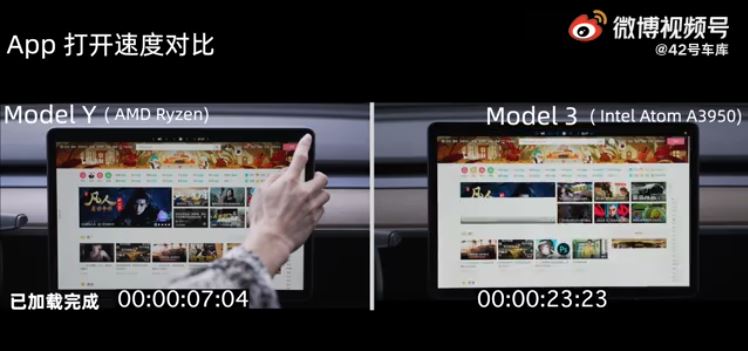Tesla Model Y Gets AMD Infotainment Upgrade, Smokes Intel In Benchmarks
Tesla's new Gigafactory in Shangai, China, has started production of updated versions of the Tesla Model Y Performance vehicle. The new models have seen a hardware change inside their infotainment systems, dropping the Intel Atom E3950 CPU in favor of an AMD Ryzen solution that has resulted in surprising performance gains.
The specific model of the AMD CPU is currently unknown, but a teardown has revealed that it appears to be the same chip that's been deployed on Tesla's revamped Model S Plaid "games console." This marks the second AMD-designed solution employed by Tesla; the company's Model X has also made the switch to AMD, leaving the company's "entry-level" Model 3 vehicle as the only one still carrying an Intel-manufactured chip.

.@xiaoteshushu GigaWorkshop Tear-down of Tesla MIC Model Y Performance. First look inside the new MCU component, GPU (AMD Ryzen) is the same as Model S Plaid.#Tesla #TeslaChina #ModelYPerformance $TSLA @teslacn @elonmusk @AMDRyzen pic.twitter.com/boiDbIiuw0November 28, 2021
Performance reports are now trickling on exactly how the switch to AMD has improved infotainment performance on the new Model Y Performance. Preliminary testing revealed more than twice the performance in dashboard app loading, as well as navigation map loading and buffering. You can see the video of the tests here.
More specifically, the YouTube-like Chinese app Youkou took only 4.18 seconds to load on the new AMD Ryzen chip, while a Model 3 sporting Intel's Atom E3950 took over four times longer at 17.12 seconds. Opening the Bilibili app was closer, but the Ryzen chip still loaded the app in only 7.04 seconds compared to Atom's comparatively-poor 24.16 seconds load time.
Tesla China quietly updating the AMD chip again? Side by side comparison of Intel Atom vs AMD Ryzen. Let us know what you think?Full Video: https://t.co/KUaJbwlhF0#Tesla #TeslaChina #ModelY #Model3 #Intel #AMD $TSLA @elonmusk pic.twitter.com/P5obSKtELZNovember 30, 2021
As one would expect, general usage is reported as being much snappier on the new AMD platform compared to the aging Atom E3950 solution. And with Tesla is certainly doubling down on the infotainment and self-driving capabilities of its vehicle fleet, it seems certain that the company will continue to pursue faster chips for its various features. Whether or not Intel will claw back its Tesla contracts in wake of the newfound relationships between the company and AMD remains to be seen.
Get Tom's Hardware's best news and in-depth reviews, straight to your inbox.

Francisco Pires is a freelance news writer for Tom's Hardware with a soft side for quantum computing.
-
$h0nuff Ugh..no specs. ARM chiplet maybe?Reply
https://www.tomshardware.com/news/amd-we-stand-ready-to-make-arm-chips
Certainly isn't standard x86 parts. -
Reply
The new models have seen a hardware change inside their infotainment systems, dropping the Intel Atom E3950 CPU in favor of an AMD Ryzen solution that has resulted in surprising performance gains.
"Surprising"? The link on the E3950 suggests that it's already 5 years old. It'd be a lot more surprising if replacing that didn't result in performance gains... -
derekullo Reply
"As one would expect, general usage is reported as being much snappier on the new AMD platform compared to the aging Atom E3950 solution"Nolonar said:"Surprising"? The link on the E3950 suggests that it's already 5 years old. It'd be a lot more surprising if replacing that didn't result in performance gains...
The article mentioned it was to be expected that AMD would perform better. -
rtoaht Reply
Some people just have surprising capability to be surprised at anything.Nolonar said:"Surprising"? The link on the E3950 suggests that it's already 5 years old. It'd be a lot more surprising if replacing that didn't result in performance gains... -
Reply
The article also mentioned that "dropping the Intel Atom E3950 CPU in favor of an AMD Ryzen solution has resulted in surprising performance gains", as I'm sure I've already quoted earlier.derekullo said:"As one would expect, general usage is reported as being much snappier on the new AMD platform compared to the aging Atom E3950 solution"
The article mentioned it was to be expected that AMD would perform better.
I don't know about you, but I don't normally expect people to be surprised at something they expected. Unless they expected something surprising, that is. But that's to be expected, unsurprisingly.